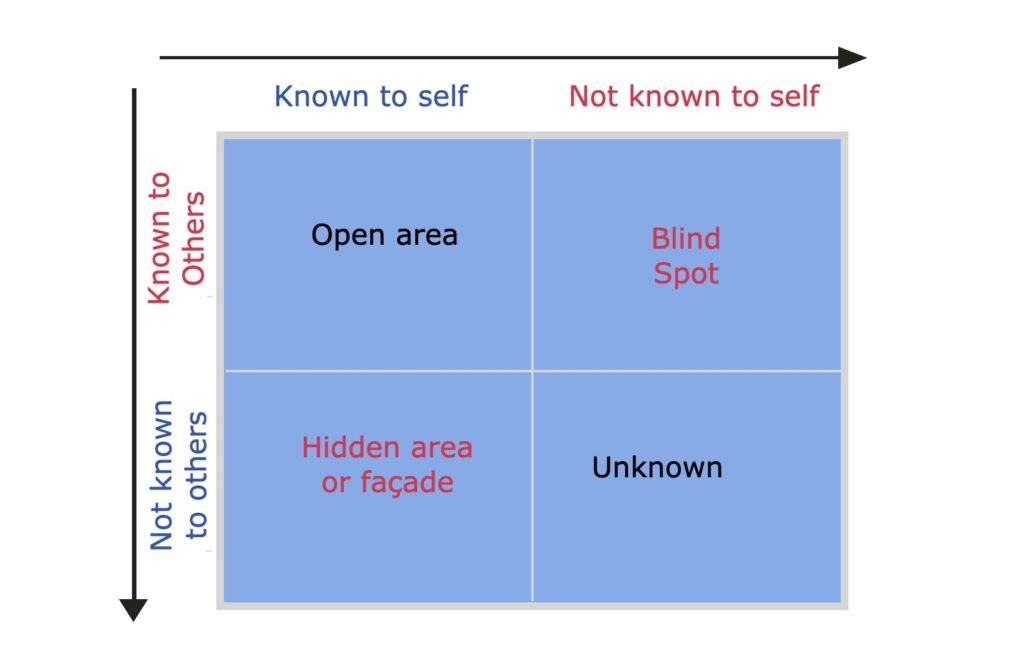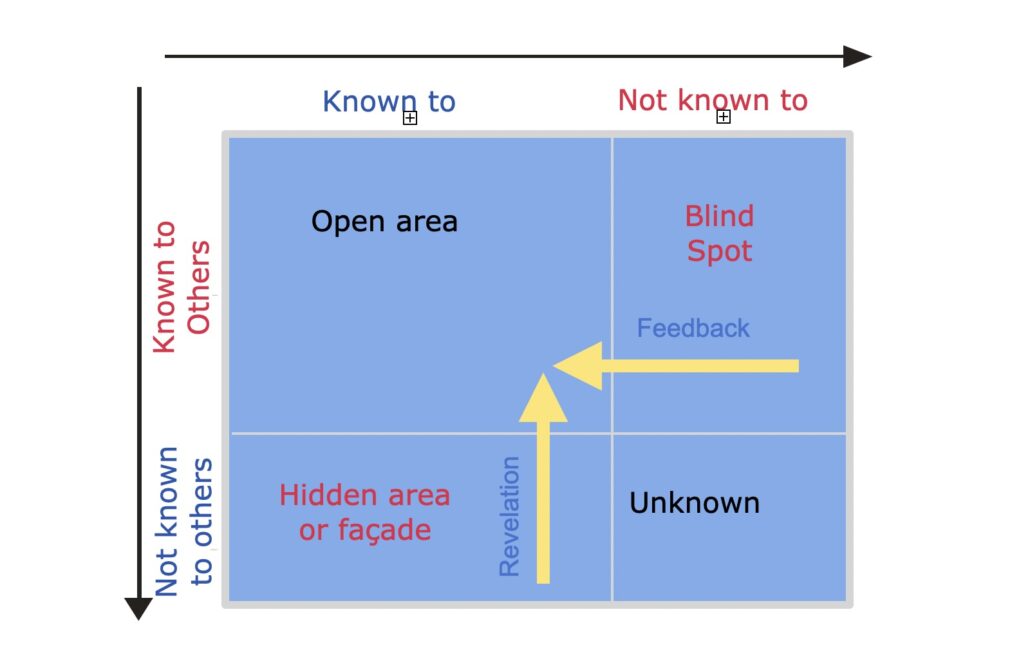Feedback is a response about how I perceive and experience the behaviour of my counterpart. I tell her or him what it is that triggers me and how I feel about it.
Constructive feedback gives orientation on how you are perceived by others and therefore makes it possible to correct behaviour that does not have the intended effect. Very often we are not aware of some areas of our own behaviour. We call these areas „blind spots“.
Inhaltsverzeichnis
Feedback – Why?
The pace and speed of change in our environment very often mean that we don’t have enough time for constructive discussions. The daily exchange is reduced to the technical topics – the daily work routine. The basic human needs for social exchange and feedback are neglected.
Feedback is an extremely valuable source of information.
In the professional environment, feedback can clarify misunderstandings and thus facilitate and sustainably improve cooperation. Over time, the ability to develop a mature communication culture increases. Most disturbances and misunderstandings do not arise at all or can be cleared up quickly.
Feedback – What is It?
Feedback is a response from the recipient of a message to the sender of the message. Feedback is not a valuation and not an interpretation but an information to the sender of the message, what I have heard, seen and understood.
Feedback is an essential part of our communication. The feedback makes clear what the „message recipient“ has understood and perceived. The „message sender“ has the possibility to correct his message or to react to the feedback. Misunderstandings are often clarified, expectations sharpened, trust built up and mutual understanding developed.
Difference self-perception – external perception
The JOHARI window (according to Joe Luft, Harry Ingham)
The difference between self-perception and external perception is illustrated in the Johari Window (named after the American psychologists Joseph Luft and Harri Ingham). Through open feedback we get the chance to change and improve our behavior.

Social learning by feedback:

Feedback in the Middle Ages – the court jester
In the Middle Ages, the role of court jester was an integral part of a court household. Court jesters were institutions of permissible criticism; they were not subject to the usual social and hierarchical norms – they enjoyed „jester’s freedom. At the same time, this also gave the rulers the opportunity to dismiss the court jester’s statements as „foolery“ and not necessarily take them seriously.
The jester’s task was to address the blind spot of his master and thus to expand his scope of action, a task that perhaps a good coach can perform today, but which should in principle be possible between all employees of a company in teams and departments and across all hierarchical levels.
Give and receive feedback – today
In order for feedback to be effective, there are a number of prerequisites between the communication partners. Both must have learned to deal with feedback. Those who give feedback should follow a few simple rules, the most important of which is probably an appreciative attitude towards the person, and the awareness that this is not about negative criticism, but about offering (giving) an external perception that is potentially helpful information for the recipient.
Feedback should therefore describe perceptible behavior as objectively and neutrally as possible. The communication of what triggered this behavior and how it was interpreted should also be described as a personal interpretation. Perhaps even more difficult than giving feedback is to accept it. All too easily we hear personal criticism and react with justification or defense.
But if we are aware that feedback is only an external perception that we receive as additional information about our actions, and that it does not have to be right or wrong, but was perceived as such by the person giving the feedback, then we can consider this feedback as a gift, gratefully accept it, and what we do with it is – as with any gift – entirely our own business.
How do I give feedback?
Giving feedback can give other people valuable information for self-assessment. But giving feedback needs clear rules:
- Check the recipient’s ability and willingness to listen to the feedback beforehand
- Feedback refers to behavior that the recipient can influence
- Speak in your own name („You affect me…“ instead of „You are…“)
- Only describe what was visible to the outside world and name one’s own reaction to it.
- Being concrete – giving examples
- Factual description of a situation instead of judging it
- Avoid interpretations
- As quickly as possible in terms of time
- Positive formulation („I wish that…“ instead of „Thou shalt not…“)
- Not only criticize, but also express positive aspects
- Make constructive suggestions for the future, which the recipient can follow.
How do I accept feedback?
An important part of feedback discussions is accepting the feedback. It is important to know: Feedback is a subjective perception of the feedback provider. This means that you usually get different feedback from different people. Everyone decides for themselves what to do with the fee feedback.
- Listening and receiving feedback
- Ask only comprehension questions
- Ask when something is unclear
- Accept the feedback (and thank you for it)
- (First) do not argue or defend themselves
- After some time (at least sleep about it) you can start talking about it
How do I recognize bad feedback?
Bad feedback can be recognized by the fact that the rules for giving feedback (see above) have not been respected. Often the supposed feedback is only given to pursue one’s own interests.
If the feedback is hurtful, personally attacking and/or condemned or given without regard to the right time, then it is a personal opinion or evaluation, but certainly no feedback. „Bad feedback“ is actually „no feedback“.
Building a feedback culture
It cannot be taken for granted that it is common and everyday practice in a group, a team or an organization to give feedback openly and frequently, and such a culture only develops under very specific conditions and hardly ever by itself.
Conducive framework conditions for the development of a feedback culture are:
- Open and constructive handling of errors
- Avoiding fear as a management tool
- Willingness and readiness for continuous learning and improvement
- Low hierarchy difference
- Exemplary behavior from „above
- Awareness of the existence of blind spots on all levels of hierarchy.
Building a feedback culture is a complex development task that requires commitment from all levels of management. Only in this way can both formal and informal feedback instruments be meaningfully installed and applied.
Advantages and benefits of a feedback culture
Improvement of the problem solving competence
Problems are addressed at an early stage. It is not about finding the guilty parties but about finding solutions together.
Mistakes are learning tasks
Mistakes are seen as a natural fact of any undertaking and are openly addressed in order not to repeat them. Information about recognized errors is also made available to others to help avoid them throughout the company.
Improvement of motivation and performance
Both employees and managers can more realistically assess their performance and capabilities. Critical issues can be addressed without impairing the willingness to perform.
Support of personal development
By addressing blind spots, all members of an organization get the opportunity to work on concrete improvements. Fields of development are pointed out and mutual support for development projects is also possible.
Realistic corporate image
Even the company management receives information that is not embellished and „edited“. Control measures become more efficient and more targeted.
Classic Variants of Feedback
Feedback in the annual appraisal interview
From manager to employee …
… strengthens behavioural patterns by naming and recognising them. Feedback makes it possible to correct one’s own behaviour that does not achieve the intended effect. It should be a fixed part of the annual appraisal interview. Nowadays, feedback from managers to employees is very common.
From employee to manager
However, feedback should also be given to superiors – in the „other direction“. The manager profits from this when he or she demands it. Managers receive important information about their own behaviour and its effects. It helps to determine one’s own location, to correct the course and thus also to achieve personal success.
Feedback on „the same level
from colleague to colleague …
… Here, too, an essential function of feedback is to clarify relationships and express needs. On the same level it is usually easier to give constructive feedback. It significantly improves the climate and thus creates a good basis for productive work, satisfaction and efficiency.
Proven forms of feedback:
- Feedback in a one-to-one conversation
- Improvement suggestions at the end of each meeting
- Feedback after a presentation
- Feedback after completion of a task
- Feedback in case of problems in the collaboration
Further formal feedback instruments
- Customer surveys
- Supplier surveys
- Employee surveys
- Supervisor feedback
- Project Evaluation Meetings
360° feedback – a special form of feedback
360° feedback is a special procedure for feedback to company executives. 360° means that feedback takes place from different perspectives. The feedback relates to the behaviour of managers in their day-to-day work.

Benefits of 360° feedback
360° feedback is used at management level and has proven its worth with a team of at least 5 people. Through 360° feedback, managers receive recognition for positive behaviour and the opportunity to correct negative behaviour. The 360° feedback can help to firstly recognise disturbing or irritating behaviours in everyday professional life and secondly to change them. There is orientation that managers need at least as much as their employees. The clear added value of the 360° feedback is the different perspectives and the comparison with the self-assessment.
The survey is usually anonymous, which has the advantage that the answers are much more honest. 360-degree feedback has become an important tool in management development.
